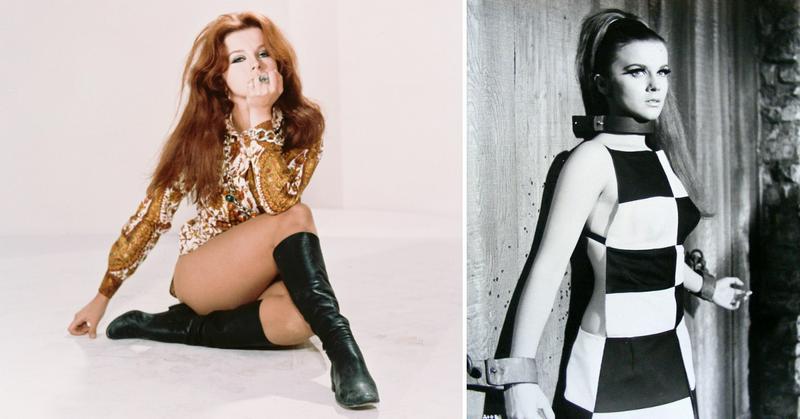Ann-Margret: Young Vixen Of The '60s, Then And Now
By | April 23, 2019

With a trio of performances in the early '60s -- State Fair, Bye Bye Birdie, and Viva Las Vegas -- Ann-Margret emerged as a sultry, multi-talented star. She's been nominated for Grammys, Oscars and Emmys, and they called her the "female Elvis Presley;" she was ever-present in the '60s and '70s as a singing, dancing and acting renaissance woman. Co-starring with such eminent actors as John Wayne, Steve McQueen, and Jack Nicholson, she warned bevy of nominations and awards, and is still going strong today with performances in Ray Donovan, The Kominsky Method, and Happy!. She collected five Golden Globes, was nominated for two Academy Awards, added six Emmy nominations, including a win in 2010, and has won a Screen Actors Guild Award. She has acted steadily for over 50 years.
A Triple Threat From The Start

A classic triple-threat star, with singing, dancing, and acting chops, Ann-Margret began her showbiz career as a live song-and-dance performer with a group called the Suttletones. She was noticed by George Burns, who invited her to join his annual Christmas show, and she released her debut album in and singer, releasing her debut album And Here She Is in 1961. She attained extremely high praise in singing, dancing, and acting that few other people ever matched. She dueted with Elvis Presley in Viva Las Vegas, but it's said that Elvis's manager Colonel Tom Parker shelved some of her performances because of concerns she overshadowed Elvis. Yet, despite impressive feats in singing and dancing, her work on screen earned her the most acclaim.
Enter The 'Sexpot-Banshee'

Ann-Margret's acting career began with a screen test at 20th Century Fox that resulted in a seven-year contract. The famously shy actress quickly shed that timid personality when she portrayed seductresses in her early roles. In her biography, she described her change in personality once she got on stage, morphing “From Little Miss Lollipop to Sexpot-Banshee." But maybe the most impressive aspect of Ann-Margret’s acting career is its breadth. She started acting in 1961 and won an Emmy in 2010! That’s nearly 50 years in the public eye, amazing longevity!
The Swinging Pleasure-Seeker

Ann-Margret's sex-kitten persona was bolstered by the roles she took -- she wasn't afraid to play up her sexuality or to appear in sensationalistic films. Following her success in Viva Las Vegas, her films included the provocatively-named Kitten With a Whip (1964), The Pleasure Seekers (1964), The Swinger (1966), The Tiger And The Pussycat (1967), and Mr. Kinky (1968). Even when the movies didn't seem obviously lurid, conventional wisdom dictated that a movie poster featuring Ann-Margret's bare midriff would sell tickets. And that probably wasn't wrong.
Ann-Margret was hailed as the next Marilyn Monroe, though with more talent and (slightly) less cheesecake appeal. But she would not be able to sustain the massive success for long.
After Her Peak

Ann-Margret didn't just make sex-kitten films -- she was also in a number of acclaimed movies with serious actors. She played Steve McQueen's love interest in The Cincinnati Kid (1966), and she was a standout in the ensemble cast of a 1966 remake of Stagecoach.
Though she had been a white-hot star in the mid-'60s, Ann-Margret's bankability waned toward the end of the decade, as she was seen as part of the Hollywood favored by the older generation -- in a sense, she just wasn't rock 'n roll enough. One post-'60s highlight was when she played what might be accurately described as Jack Nicholson's lust interest in Mike Nichols' brutal 1971 exploration of relationships, Carnal Knowledge. The performance earned her an Oscar nomination for Best Supporting Actress and a Golden Globe in the same category.
An Unexpected Tour De Force

By the mid-'70s, Ann-Margret was approaching her mid-30s, and her career had definitely slowed. The Train Robbers, from 1973, paired her with John Wayne, who would later remark "When I die, I want Ann-Margret to dance on my coffin. If you don't see me in five minutes, you'll know I'm dead for sure." But after that film, she didn't make a movie for two years. Then came a moment of brilliant casting, when she was selected to play Nora in Tommy, the 1975 film version of The Who's rock opera. Her performance, which included a memorable scene where she writhes in a pool of baked beans and chocolate, was universally praised. She was nominated for an Oscar for Best Actress and won her third Golden Globe.
Accident-Prone

While her career constitutes an unmitigated success, she managed to do it while enduring a few traumatic injuries. In 1972, Ann-Margret fell 22 feet while performing in Lake Tahoe, breaking her face and arm in the fall. The accident required hours of facial reconstructive surgery to put her back together. Amazingly, she returned to stage without any problems. Ann-Margret also loved riding her motorcycles. In 2000, at the age of 59, while riding she was thrown off, sustaining numerous injuries. Despite the severity of the crash, she went on Larry King not long after and joked about the incident.
Ann-Margret's Legacy

Ann-Margret's career can’t be classified as anything other than a roaring success. She continued acting throughout the '80s, '90s and into the 21st century, often as a featured star in TV productions. Looking back at her endless accomplishments, it seems the one that eluded her is the "next Marilyn Monroe" hype. She peaked just as American tastes were changing, and musicals or movies with song-and-dance numbers were waning in popularity. Perhaps it's time for a re-evaluation of Ann-Margret's career -- after all, she merely acted, danced, and sung her way into the hall of fame. Ann-Margret may just be a classic example of consistent greatness, not earning her proper due.
